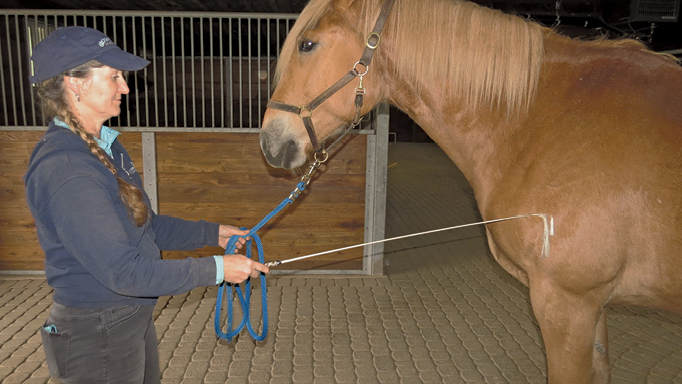This barging behaviour is sometimes about space – in the horse’s world, whoever owns the space and can move another horse out of that space determines the herd hierarchy. But barging behaviour is often caused by anxiety. The horse is anxious to get out of the paddock (eg. anticipating being fed, wanting relief from bugs, or is the last one brought in); to protect his space in his stall; or to come out of the stall (eg. anticipating being turned out).
Some people handle barging behaviour with a chain on the horse’s nose, striking him with a whip, waving their arms, or shouting. While these techniques may work in the moment, they create more stress for the horse and you.
In order to have a positive partnership with your horse, remember that you must:
• respect his personal space (the bubble around his head and neck) while asking him to respect yours
• help him move with a calm, healthy posture
• focus on helping him release tension
Depending upon how strongly your horse pushes and how stressed he is, you may need to use a whip for this exercise. A dressage whip gives you enough length to be a safe distance away if the horse strikes, bites, or kicks.
Ask Your Horse to Back Up. Stand in front and slightly to the side of your horse so that you’re not directly in front of his feet. Point at, press on, or gently tap your horse’s chest with your hand. At the same time, keep your core energy aimed toward his chest, making sure neither your core nor your upper body are pushing towards his head.
Ask Your Horse to Move His Front End Away. Stand about six to 12 inches away from your horse, facing his shoulder. Use the same methods as for backing up, but by applying the pressure to, and aiming your core at, the shoulder.
If you feel your horse shift his weight away from your push even slightly, remove the pressure immediately. If he pushes into your push, try more direct pressure by using your fingertips, thumb or the whip handle. It’s more effective on a horse that pushes back or stoically does nothing to give a series of short strong pushes (one or two seconds each) followed by a release (of one or two seconds).
If your horse is still not shifting away from you, tap him gently once on the chest or shoulder with the whip, or even the end of your lead rope. Tap once and wait a second or two. Repeat. Watch carefully for the horse to either stop pushing into your push or to shift his weight away even a bit. Praise him for the ‘try’ – the slightest move in the right direction.
While you are asking your horse to move away, pay attention to his posture. If he raises his head and braces, it’s a sign that he’s feeling physically and mentally tense and stressed. Stop and take the time to encourage him to lower his head with a gentle downward pressure and slight side-to-side rocking on the lead rope, halter, or nose and poll. Breathe and release any tension in your own body as you do this. Remember that your horse is affected by how you’re feeling. Don’t hurry. Take as much time as it takes to for him to release the tension and bracing before asking him to move away again.
As you practice consistently asking your horse to move away in this manner and correcting him any time and every time he moves into your space uninvited, it will require less effort and energy for your horse to move away. Then, when you’re at his stall door or the paddock gate and you want more space, you can simply point at his chest or shoulder and he’ll move away calmly and politely.

